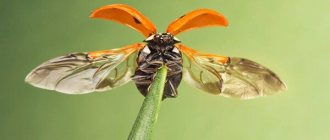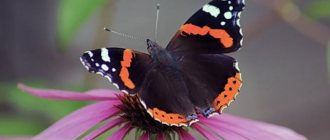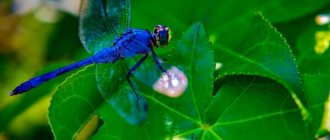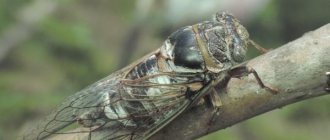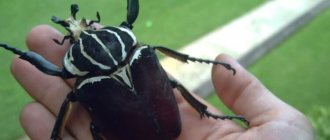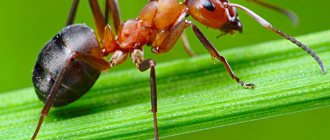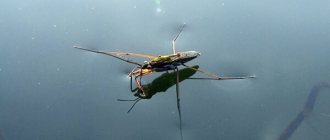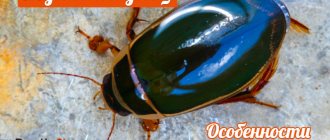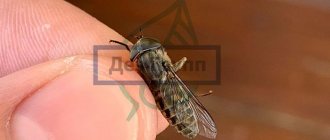The cabbage butterfly is a diurnal representative of the order Lepidoptera of the class of insects. Its other name, white butterfly, symbolizes its color: white wings with small black dots in the center. Whitefish can be seen already in the spring in April or May, fluttering over the first green plants.
Interesting!
Some lovers of lepidopteran insects breed butterflies in their home aquariums. How long cabbage butterflies live in an artificial environment depends on care. They eat the same plants at home as in nature.
But the cabbage butterfly did not gain fame due to its early appearance. It is a dangerous pest of gardens and vegetable plantations. Its larvae are capable of damaging most vegetable crops over the course of a season, although this is not the only thing the caterpillars feed on. Cabbage beds are especially affected by caterpillar infestations. This explains why the insect was named so.
Description and appearance
The cabbage butterfly is a butterfly from the white butterfly family and belongs to the class of insects, a type of arthropod. The insect received the specific name “cabbage plant” due to the fact that cabbage is one of the main food plants for caterpillars. This is a fairly large representative of the Lepidoptera order; its wingspan can reach 60 mm.
The description of the cabbage butterfly should begin with its distinctive feature, namely its wings. The cabbage white butterfly has four wings, which are powdery white on the upper side. The corners of the front wings are black; in females, the pattern is supplemented with black spots. The underside of the wings of females is greenish, while that of males is closer to yellow. This is an excellent disguise. When the cabbage butterfly folds its wings, it is difficult to see it against the background of the grass.
Appearance
The body of the white butterfly is dark and covered with hairs. On the head there are large eyes and rather long antennae. Six legs with sharp claws, thanks to which the insect is held on to plants. The legs themselves are weak, so the butterfly practically does not crawl.
Lifespan
The cabbage butterfly lives under favorable conditions for up to 75 days. During this time, it goes through 3 transformations from egg to adult - imago. In butterfly form, the cabbage butterfly lives only about 20 days, feeding on nectar and giving life to a new generation, after which it dies a natural death.
Expert opinion
Victoria Neima
The flight time of the first generation occurs in mid-April and lasts until early June. Butterflies that can be found from mid-July to mid-August are the second generation. And, if the climate allows, the third generation flies from September to October. In the northern latitudes, with cold, short summers and long winters, only two generations of butterflies have time to change, in the southern regions - three and even five.
Subscribe
Lifestyle and habitat
Cabbage whites are found in Europe, Africa, Australia, Japan and Asia. In Russia, this butterfly can be found in almost all regions, with the exception of the Far North.
Cabbage butterflies are daytime butterflies. They can be seen in parks and gardens, in meadows and forest clearings, in vegetable gardens and roadsides. Cabbage white caterpillars reach a length of 2.5 - 3.5 cm, but due to their green body with dark spots they are not easy to notice in dense foliage. However, the presence of caterpillars on cabbage very soon becomes noticeable, as they gnaw the leaf from the edges to the veins.
Butterflies love open spaces, but do not fly far from a food source. They are mainly active in sunny weather, and when it is cloudy, they sit on low bushes or grass with half-opened wings. The most comfortable temperature for cabbage is from 20 to 25⁰С.
Notes
- Korshunov Yu. P.
Keys to the flora and fauna of Russia // Mace Lepidoptera of Northern Asia. Issue 4. - M.: Partnership of Scientific Publications KMK, 2002. - P. 39. - ISBN 5-87317-115-7. - Striganova B. R., Zakharov A. A.
Five-language dictionary of animal names: Insects (Latin-Russian-English-German-French) / . - M.: RUSSO, 2000. - P. 266. - 1060 copies. — ISBN 5-88721-162-8. - Gornostaev G. N.
Insects of the USSR. - Moscow: Mysl, 1970. - 372 p. — (Reference books for geographers and travelers). - Gorbunov P. Yu., Olshvang V. N.
Butterflies of the Middle Urals: A reference guide. - Ekaterinburg: “Socrates”, 2007. - P. 257. - 352 p.
Reproduction and life cycle
The development cycle of the cabbage butterfly includes 4 stages:
- egg;
- larva (caterpillar);
- chrysalis;
- adult insect.
After mating, the female lays eggs on the underside of leaves of plants from the cruciferous family. During its life, a butterfly can lay 200 to 300 eggs. Cabbage eggs are light yellow and shaped like a cone. After about 10–20 days, cabbage white larvae hatch from the eggs.
Life cycle
At first the caterpillar is yellow-green, but gradually its color changes to gray-green with dark spots and streaks. The larval stage can last from 14 to 25 days, during which time the caterpillar molts four times. Then the caterpillar crawls from the plant to a stone, fence, tree, attaches itself to it with a silk thread and pupates. The cabbage pupa is angular, greenish-yellow with dark dots. This stage of development of the cabbage white butterfly lasts from 10 to 15 days, depending on weather conditions.
It often happens that the pupa hibernates, overwinters, and the butterfly appears the very next year after the onset of warm weather.
Egg stage
The frequency of butterfly reproduction depends on temperature conditions. The warmer it is, the more often reproduction occurs, generally two to three times. In light of this, egg laying can occur from April to September.
After mating, the female lays about 200 or more eggs. The first laying is made on wild plants. But already 2 and 3 clutches can be produced on cultivated plants in the gardens of summer residents.
What does cabbage eat?
The cabbage white butterfly, like most butterflies, feeds on flower nectar. They choose a flower, descend on it and suck out the life-giving moisture with the help of their proboscis. Of the many flowering plants, butterflies prefer:
- cornflower;
- dandelion;
- alfalfa;
- thistle;
- meadow greenweed;
- marjoram.
But cabbage caterpillars are much more harmful to crops than adult butterflies, since they feed on plant leaves. It is the larvae that are the reason why cabbage grass is considered a dangerous pest. Green caterpillars most often occupy the leaves of plants from the cruciferous family, namely:
- different varieties of cabbage (white cabbage, cauliflower, Brussels sprouts, kohlrabi);
- radish;
- radish;
- rape;
- turnip;
- rutabaga;
- mustard.
Cabbage caterpillars eat other plants, for example:
- capers;
- mignonette;
- nasturtium.
The caterpillars stick together, quickly eating the leaves, of which very soon only veins remain. Having finished with one plant, insects crawl to neighboring ones, thus causing serious damage to the plantings.
Taxonomy
Cabbage belongs to the genus of garden whites ( Pieris
) within the subfamily Pierinae. Its representatives are characterized by antennae with a capitate club. The wings on the upper side are white with dark spots, the veins are not contrasting. The background of the underside of the wings lacks a clear pattern. The wing veins R4, R5 and M1 have a common trunk. Sexual dimorphism in representatives of this genus is expressed in a more strongly developed dark pattern on the wings of females.
There are several subspecies of cabbage:
Pieris brassicae brassicae is the nominate subspecies. Its range includes the following territories: mainland Europe, the Mediterranean, northern Africa, Turkey and Asia Minor, east to the Urals, the Caucasus and the Zagros. Within the subspecies, some researchers distinguish three subraces - Northern European, Mediterranean and Syrian.
Pieris brassicae azorensis Rebel, 1917. Sometimes considered by some researchers as an independent species. A number of researchers, on the contrary, consider the taxon as an unstable island form, indistinguishable from the nominative subspecies. Endemic to the Azores. The butterflies are similar to the chariclea form of the nominate subspecies with darker undersides of the hind wings. Butterflies of this taxon are usually larger than mainland cabbage butterflies.
Pieris brassicae nepalensis Gray, 1846. Its range includes the following territories: Pamir, from Balochistan, the Himalayas to Northern India and Assam and the lowland areas adjacent to the Himalayas to Yunnan (China). This is one of the most common butterflies of the Himalayas at altitudes of 1000-4000 meters above sea level.
Pieris brassicae ottonis Röber, 1907 Its range includes the following areas: Northern Tien Shan, Kyrgyzstan, most of Afghanistan and probably Iran, at high altitudes up to 2500 meters above sea level in the Pamirs.
Pieris brassicae catoleuca Robert 1896. Some researchers consider it as the so-called. Syrian race/subrace of the nominative subspecies. Described from Turkey. The range extends from the Taurus Range (Turkey) south to Asia Minor, including Israel and Cyprus.
Pieris wollastoni to be a subspecies of the cabbages
Butler, 1886. An extremely rare, possibly already extinct taxon with a limited range - endemic to the island of Madeira, where it was confined to the edges, woodlands and clearings of relict Monteverde forests, formed mainly from laurel trees at altitudes of 650-1200 meters above sea level . In most cases, the taxon is considered as an independent species.
Related species
According to the morphological characteristics (appearance) of butterflies, the turnip ( Pieris rapae
).
The latter is distinguished by its smaller size (front wing length 22-30 mm; wingspan 40-50 mm) and the fact that at the ends of its front wings the black color is less intense and the area of the black area is smaller. Also common is the rutabaga whiteweed ( Pieris napi
), which is similar in morphology to the cabbage whiteweed.
Damage caused by the cabbage butterfly
As already noted, the real pest is not the imago, but the caterpillar of the cabbage butterfly. It is at this stage of development that the insect poses a real danger to fields and vegetable gardens. Butterflies are quite prolific, and the larvae are very voracious. An infestation of caterpillars can cause the destruction of a significant portion of the crop.
Caterpillars
But it’s not just plants that can suffer from caterpillars. The fact is that the larvae secrete a poisonous toxin, which can cause the death of the bird after it eats the caterpillar. If a toxic substance comes into contact with human skin, it may cause irritation.
Doll
What does a cabbage butterfly look like in the pupal stage? The color is almost the same as that of the butterfly - yellowish-green with black splashes.
When transitioning to the pupal stage, the larva is wrapped in threads somewhat reminiscent of silk, and with them it clings to plants.
If the folding into a chrysalis did not occur too late, then a butterfly will soon be born. If the atmospheric temperature does not allow the transformation to occur, then the insect enters the diapause stage and overwinters. With the onset of spring, such insects begin their first generation.
For information, diapause is the process of inhibition of physiological processes in an insect with a transition to the stage of suspended animation.
The insect remains in this stage for several weeks. During this period, the pupa molts several times, and this process is called complete metamorphosis.
How to get rid of it?
Pest control mainly consists of destroying the larvae that pose a threat to crop plants. Both chemicals and folk recipes help get rid of caterpillars on cabbage and other crops. In addition, gardeners use herbal decoctions, biological preparations, traps and natural enemies of whitefish.
Insecticides
Insecticidal preparations are the most effective method of pest control. Before using them, you must carefully study the instructions, and then act, observing the dosage and remembering the precautions.
The most popular insecticides for cabbage include:
- Kinmiks;
- Spark;
- Fufanon;
- Karate.
Due to their high toxicity, such products are recommended to be used to get rid of caterpillars on cabbage in case of severe infestation. If the situation has not gone too far, you should try to use safer means, for example, biological products.
Biological products
The composition of biological products allows you to treat cabbage and other plants throughout the entire growing season. The only time when processing is not recommended is immediately before harvesting. The most effective products from this category:
- Fitoverm;
- Actofid;
- Vermicide;
- Lepidocide.
Biological methods show good results only in the case of not too extensive damage by caterpillars.
Folk methods of struggle
Folk remedies for caterpillars on cabbage have been known for a long time and have proven their effectiveness more than once. Such methods are absolutely safe for humans and plants and at the same time cope well with pests. The following folk recipes are most often used:
- pollination of affected leaves with dry tobacco dust;
- sprinkle baking soda on affected plants;
- spraying with herbal infusions.
Spraying
The easiest option is to collect caterpillars by hand, but it will require a lot of time, effort and patience, so it is only applicable at the initial stage of infection.
Traps
Many gardeners act comprehensively and fight both caterpillars on cabbage and butterflies to prevent the laying of eggs and the appearance of new pests. Traps are used to catch butterflies. These can be adhesive tapes hung next to the beds, or traps with sweet bait in the form of jam or syrup with the addition of brewer's yeast, placed between the rows. When deciding to use traps, you need to take into account that not only pests, but also beneficial insects can get into them.
Recipes for infusions for spraying plants
One of the most common methods of combating caterpillars is the use of a variety of herbal infusions for spraying or watering. Several popular and effective recipes:
- pine decoction (200 g of pine needles or cones per 1 liter of boiling water, leave for a week, dilute with a bucket of water);
- mustard decoction (100 g of mustard powder per bucket of hot water, leave for 2-3 days);
- Pour 1 kg of fresh potato tops with a bucket of boiling water, leave for 4 hours, strain, add a little crushed laundry soap;
- Mix 0.5 kg of wood ash with 10 liters of water, leave for 3-4 hours, add 2-3 tbsp. l. liquid soap;
- Boil 1 kg of dried wormwood in 1.5 - 2 liters of water for 15 - 20 minutes, when it cools down, pour the decoction into a bucket of water;
- per bucket of water 50 ml of ammonia;
- Fill a bucket one-third full with crushed burdock leaves, add water, leave for 4 days, strain and water the affected plants;
- 1 bottle of pharmaceutical valerian per 3 liters of water, apply immediately after mixing.
For spraying, you can use salt water (2 full tablespoons of salt per bucket of water).
Chemicals
If folk remedies are powerless, then it is recommended to resort to chemicals. Of course, it is worth choosing safer options - biological control agents. They do not harm the plant and help cope with dangerous insects. It is worth paying attention to such products as Fitoverm, Lepitotsid.
However, in large areas it is better to give preference to serious chemistry - Karbofos, Actellik. The solution is prepared strictly according to the instructions, and the plants are treated only at the stage of leaf formation.
Knowing what harm cabbage grass causes, it is necessary to carry out preventive treatment of agricultural crops in a timely manner in order to grow a good and full harvest. To get rid of insects, you can use traditional methods; if necessary, use chemicals that are prepared strictly according to the instructions. Proper planting of plants of the same species will also help to avoid pests, as well as planting flowers that cabbage does not like.
How to protect your garden from cabbage weeds?
The following recommendations will help protect your garden and future harvest from the white-winged pest:
- already at the beginning of summer it is necessary to remove cruciferous weeds from the beds;
- beds with crops that attract cabbageweed should be located at a distance from each other;
- between beds with cabbage and other cruciferous vegetables, carrots, dill, and parsley are planted, which attract natural enemies of pests;
- to protect cabbage from the caterpillars of the white butterfly, tomatoes are planted next to it (the pest also cannot stand the smell of lemon balm, marigold, valerian);
- at the end of the season in the fall, it is necessary to dig up the area so that pests cannot overwinter in the ground;
- It is advisable to plant cruciferous vegetables in different places each season.
In addition, you need to regularly inspect the leaves of plants in order to notice eggs and larvae in time and take action.
Prevention measures
Prevention of the appearance of Cabbage White is the timely destruction of pupae and oviposition. To prevent the spread of the pest, you must do the following:
- periodically inspect the underside of the leaves of cruciferous plants and destroy the eggs found;
- inspect dry branches, tree trunks, barn walls and other places where pupae may overwinter;
- Regularly carry out spring whitewashing of tree trunks and main branches.
Pest biology
The cabbage butterfly belongs to the white butterfly family and is a diurnal butterfly; it is also called the cabbage white butterfly. It must be said that this family also includes insects such as:
- repnitsa;
- rutabaga;
- hawthorn.
The structure of the cabbage plant is the most common: it has two pairs of wings on a short, dark-colored body. The wingspan of the cabbage butterfly is up to 62 millimeters.
Why the butterfly is called the cabbage butterfly is clear to everyone: cabbage and other cruciferous vegetables are the favorite food of these white butterflies.
Habitats
The cabbage white is found almost throughout the entire territory of Russia with the exception of the Far North. You can say this: when the cabbage grows, so does the butterfly.
As for the territory it occupies in nature, the whitefish does not have a clearly defined connection to certain places. She actively migrates in search of food and can be found anywhere:
- on the edge of the forest;
- in the meadows;
- in fields with cruciferous crops;
- and of course, vegetable gardens.
Nutrition
As is often the case with other arthropods, cabbage grass insects feed differently: adults eat pollen from flowering plants, and larvae feed on leaves of cruciferous crops.
The following plants can be considered as what the cabbage butterfly and its adult insects feed on:
- coltsfoot;
- dandelions;
- meadow greenweed;
- chamomile;
- alfalfa;
- and many others.
At the same time, the female lays eggs on cruciferous crops, on which the insect subsequently develops. The following wild and cultivated plants can be considered food items:
- rapeseed;
- hiccup;
- sverbiga;
- shepherd's purse;
- dyeing woad;
- all types of radishes;
- cabbage of all kinds;
- radish;
- swede;
- turnip;
- horseradish;
- mustard.
Microorganisms
Microorganisms are airborne or introduced through damage caused by other pests. There are obligate microorganisms that do not exist outside the plant, and conditionally phytopathogenic microorganisms that can live in other environments. The first group is dangerous because, being unable to exist outside the host, it uses its full potential, significantly weakening agricultural crops. The second form can be transmitted over long distances and cover large areas. Just like insects, garden pests are highly specialized in one group of plants. Damage to plants is caused by:
- Viruses - characteristic damage: mosaic spots, mottling, deformation of shoots and general weakening of growth. A typical representative is tobacco mosaic in cucumber crops.
- Bacteria - the disease occurs in the form of necrotic changes in tissues.
- Fungi cause more than 80% of all plant diseases. They use plant parts and fruits as a substrate for growth. Phytopathogenic fungi can be unicellular or multicellular.
- Actinomycetes, or radiant fungi, are a type of bacteria that live in soil. They perform an important environmental task during the decomposition of solid substrates. There are parasitic forms.
- Mycoplasmas are characteristic features of the disease: small leaves and low seed content.
Nutrition
The butterfly's proboscis is intended only for obtaining nectar. The adult is completely harmless, but its offspring cause enormous harm to agriculture. Farmers protect their land and crops in many ways. Some treat the fields with specialized preparations, but this is an ineffective procedure; competent farmers try to clear their fields of grass and debris as much as possible in the fall.
Butterfly caterpillars are extremely voracious and, if left unchecked, can destroy the entire cabbage crop. This shows their similarity with many other species. Its relatives, which do not harm plants, produce caterpillars that eat the leaves of garden trees.
